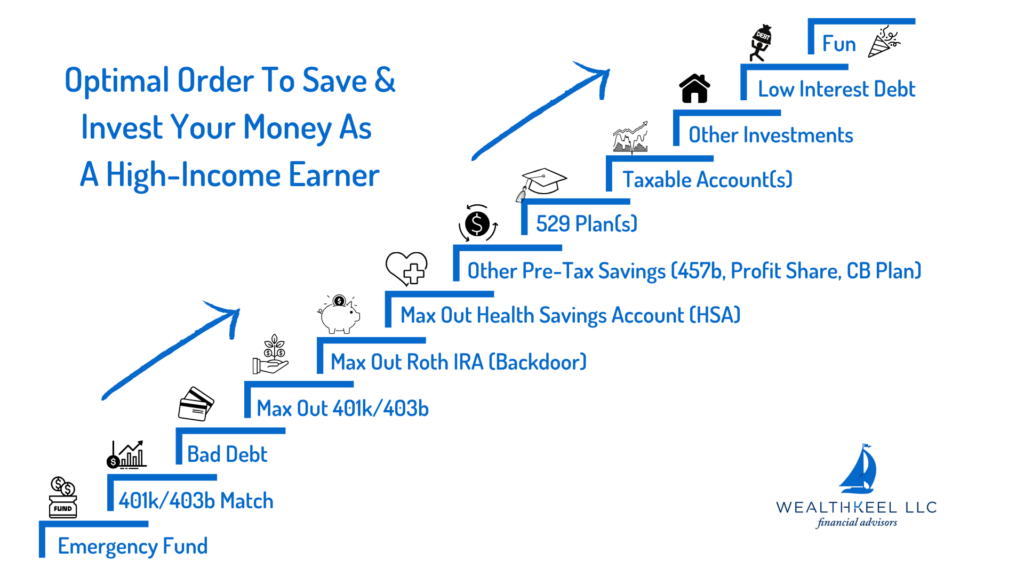As a high-income earner, managing your finances strategically is not just beneficial—it’s essential. The journey towards fiscal stability and growth involves prioritizing where and how you allocate your resources across various investment vehicles and savings accounts. In this post, I’ll guide you through a systematic approach to managing your finances, from establishing an emergency fund to investing in low-interest debt. This structured path will help you leverage your earnings for long-term wealth accumulation.
🎥 Prefer video over the blog? We’ve got you covered!
Watch our YouTube video as we dissect this blog post for you 🎥
Establishing Your Financial Safety Net: The Emergency Fund
The cornerstone of any solid financial plan is the emergency fund. As predictable as life may seem, unforeseen expenses are par for the course. An emergency fund acts as your financial buffer, alleviating stress during such unpredicted scenarios. Financial experts recommend saving anywhere between three to six months’ worth of expenses. The psychological comfort of having this fund cannot be overstated—it’s a critical first step for every high-income earner.
Maximize Employer-Sponsored Retirement Plans
Once your safety net is established, the next step is to focus on your employer-sponsored retirement plans like the 401(k) or 403(b). If you’re employed in a sector that offers matching contributions (like many healthcare positions in academia), not taking full advantage of this is akin to leaving free money on the table. Aim to at least contribute enough to capture all available employer matches, as this is essentially a 100% return on your investment.
Addressing High-Interest Debt
With your emergency fund in place and your retirement plan underway, it’s time to tackle high-interest debt. This often includes credit card debt and potentially onerous car loans. The interest rates on these can erode your financial health, making it crucial to pay them down aggressively. By prioritizing high-interest debts, you free up more of your income for other investments and decrease the total interest paid over time.
Broadening Your Retirement Savings
After addressing high-interest debt, look to max out your 401(k) or 403(b) contributions. Contributing the maximum allowed amount can significantly reduce your taxable income and bolster your retirement savings. In 2025, the contribution limit for these plans is $23,500. High-income earners should strive to hit this cap to optimize tax benefits and accelerate the growth of their retirement funds.
Leveraging Roth IRAs Through Backdoor Conversions
The next step in the optimal order to save involves the Roth IRA. Due to income limits on traditional Roth IRA contributions, high-income earners might need to utilize a backdoor Roth IRA—a legal strategy that involves converting a traditional IRA into a Roth IRA. This vehicle offers tax-free growth and withdrawals, making it an excellent tool for future financial flexibility.
Health Savings Accounts (HSAs): Triple Tax Advantages
A Health Savings Account (HSA) represents another powerful saving instrument, especially if you are enrolled in a high-deductible health plan. HSAs offer triple tax benefits: tax-deductible contributions, tax-deferred growth, and tax-free withdrawals for qualified medical expenses. Given the rising cost of healthcare, maximizing contributions to an HSA can provide substantial financial benefits as you age.
Additional Pre-Tax Savings Opportunities
For those with access to 457(b) plans or involved in academic medicine, consider further maximizing these opportunities. These plans can supplement your other retirement savings, offering deferred taxation on growth until the money is withdrawn.
Educational Savings: The 529 Plans
Investing in a 529 plan for college savings comes next. These plans offer tax-free growth and withdrawals for qualified educational expenses. Some states also provide tax benefits for contributions, making 529 plans an attractive option for saving for your children’s education.
Building Flexibility Through Taxable Investment Accounts
Establishing a taxable investment account provides flexibility as you continue to flesh out your financial foundation. Unlike retirement accounts, taxable accounts have no contribution limits and offer more accessible funds without early withdrawal penalties. They are ideal for saving towards mid-term goals or even early retirement.
Exploring Other Investment Avenues
Finally, for those interested in additional investment forms like real estate or small businesses, these should come after ensuring your primary financial bases are covered. Such investments can offer significant returns but often come with higher risks and demands more involvement.
Conclusion: Put Your Plan into Action
The optimal order to save and invest as a high-income earner involves a balanced, structured approach focusing on both security and growth potential. Starting with basic safety through an emergency fund, progressing through tax-advantaged retirement accounts, addressing debts, and finally diversifying into other investments ensures a comprehensive strategy tailored to maximize your financial success. Remember, personal finance is just that—personal. Adjust this blueprint as necessary to fit your specific circumstances and goals, ensuring it aligns with your long-term financial ambitions.
Looking for a more thorough all-in-one spot for your financial life? Check out our free eBook: A Doctor’s Prescription to Comprehensive Financial Wellness [Yes, it will ask for your email 😉]

